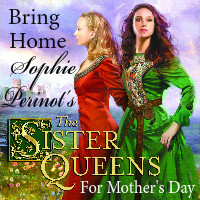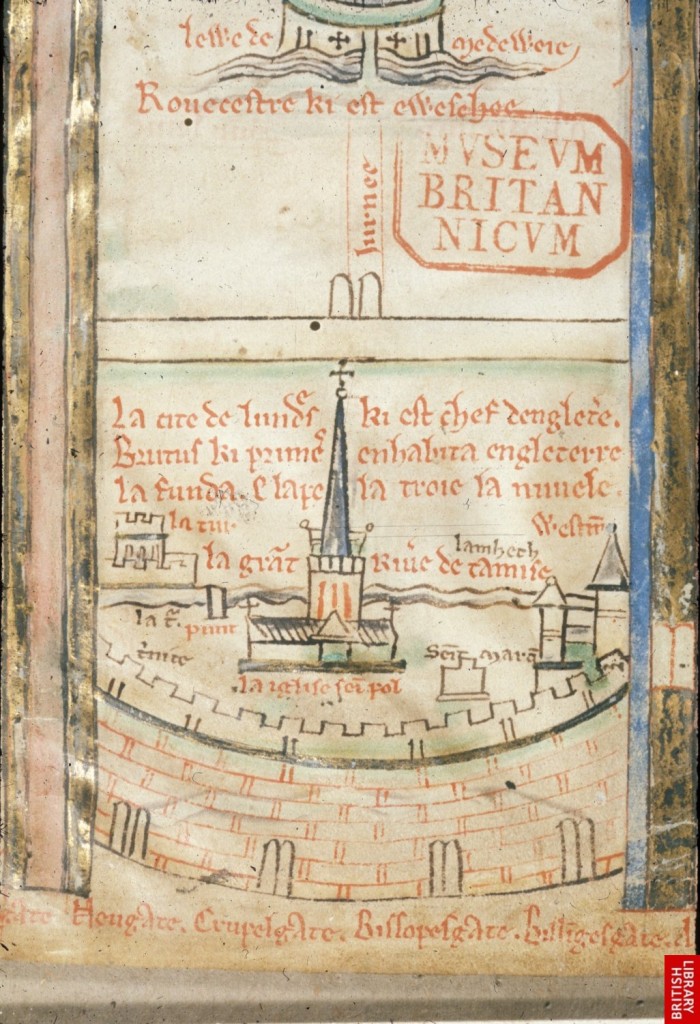Category: For Historical Fiction Fans
Why I Want Books For Mother’s Day
Mother’s Day is a “brunch holiday.” I detest brunch. There is something so very non-committal about it. Besides, all the best food (not to mention the alcohol to go with it) comes out after dark. In the early years of being a mother I devoted considerable time and energy in the month of April to oh-so-subtly delivering my anti-brunch message (my husband comes from a Mother’s-Day-Brunch family). By the time we had two toddlers I’d given up on subtle and had “Sophie hates brunch” tattooed on hubby’s arm. Let’s face it there is NOTHING relaxing or celebratory about trying to consume a meal in a nice restaurant with two toddlers. And, crazy as it may seem, I’ve always been under the impression that a gift is supposed to delight and relax its recipient.
Motherhood is not, generally speaking, a relaxing occupation. Everything is prone to interruption. Everything. If you are a mother and you’ve been drawn, shampoo-still-in-hair, from the shower by disturbing sounds from elsewhere in your house—sounds suggesting that either furniture or children are being broken—then you know precisely what I mean. The TRULY perfect Mother’s Day gift would be an exotic getaway. A weekend on a beach inBali. Shopping inParis. A day at the spa. Heck, I drive past a Dominican retreat on my appointed motherly rounds, and lately I’ve been thinking a day with the nuns would do wonders for me. Please note, I am not even Catholic.
The truth is, for many of us, an actually physical getaway is pipe dream. There are kids to be delivered to and from a myriad of activities (anyone who’s had a “oh my god I forgot to pick up [insert child’s name here]” moment, raise your hand), homework to help with, etc. And can you just imagine the size of the laundry pile that would await a mother’s return should she actually manage to slip away toBali?
But being a mom is a joy and an avocation. It’s taught me a lot of things including how to live in the moment. After two decades of motherhood I know that I need to both treasure and expect my “me time” in small increments. You have perhaps heard of the twenty-minute power nap? Well, I have become the master of the eleven-minute sitting-in-the-car-getaway. And that leads me to books.
Books offer the perfect, portable, getaway. I may look like I am in the carpool line, waiting for the man with the whistle to call a hundred car engines to life, but I am not. I am in ancient Rome thanks to Kate Quinn’s Empress of the Seven Hills. I am in regency England watching a confirmed bachelor-dandy fall head-over-heels thanks to Miranda Neville. I am spending an afternoon with Catherine de Medici thanks to biographer R. J. Knecht. I am attending festivities at the Valois court with Philippe Erlanger. I am discovering a set of sisters from Provence in a secondary research source on Notre Dame de Paris—sisters who will lead me on an adventure ultimately resulting in the publication of my debut novel, The Sister Queens.
The cost of these getaways is negligible (certainly not in the league of airline tickets to Bali). For the cost of a brunch I’d hate for the five of us, my family can get me a whole armload of books I’ll love and that will fit into my schedule. Yes, I may get snappish when I am forced to put down a novel at a climatic moment to help find a uniform skirt gone missing, or “check” on someone who has already been in bed for an hour but is still not asleep (you know who you are, son). But it’s a lot easier to settle back down on the couch and slip back into the French Revolution with Michelle Moran’s Madame Tussaud than it is to sop up all the water and suds from interrupted tub-time. When I travel by novel I can get back home from Paris for tuck-in time. Try doing that by airplane (especially in a TSA infested air-travel world).
So, husband dearest, books please. Mother’s Day is still more than a week away. Don’t make me tattoo this on your. . . oh, never mind.
My First Author Appearance! And in VERY Impressive Company!
You’ve read my blog. You’ve read my book. Now I’d love to meet you.
On April 21st I’ll be joining the fabulous and talented Kate Quinn (Mistress of Rome, Daughters of Rome, & Empress of the Seven Hills) and Stephanie Dray (Lily of the Nile & Song of the Nile) for a “literary threesome” in theWashingtonDC metropolitan area.
Come on out to hear us discuss Sex, Lies and History, and make the acquaintance of some amazing historical women—Cleopatra’s daughter; a host of patrician Roman women (including an empress and the daughter of a Senator); and, of course, my pair of 13th century Provencal sisters who became the queens ofFrance andEngland. In addition to a lively panel discussion, all three of us will be signing books. It’s a triple historical fiction treat!
Here are the details:
Date: April 21st
Time: 1-3 p.m.
Location: Barnes & Noble,Spectrum Center, 1851 Fountain Drive, Reston, VA20190
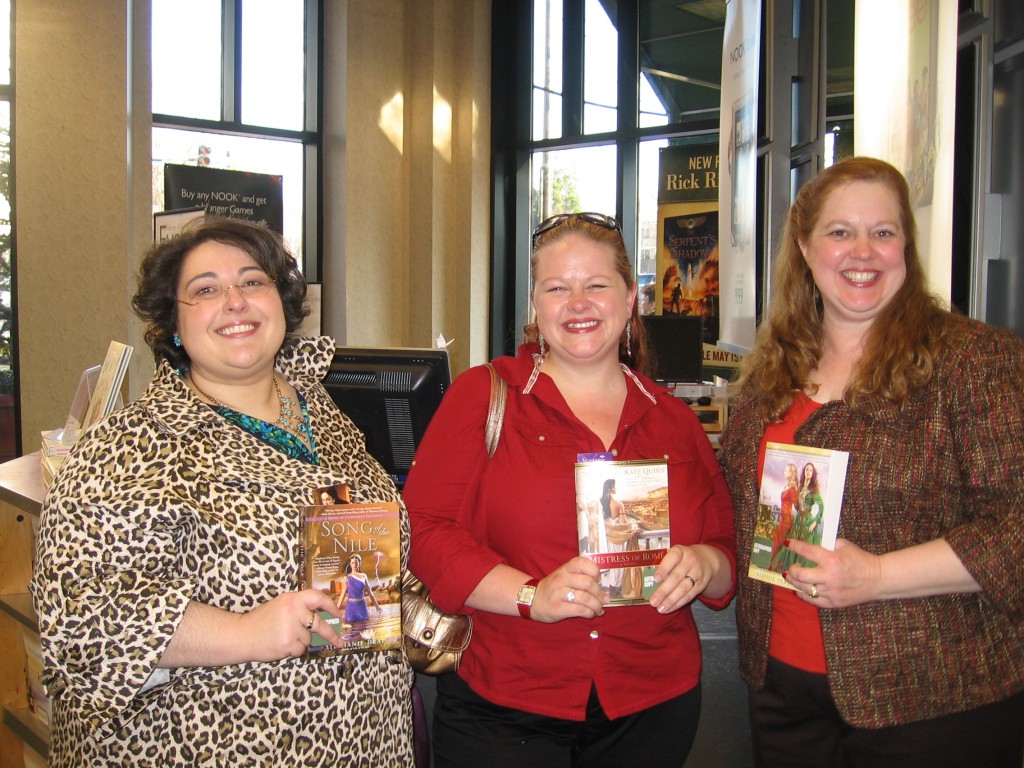
Calling All New England Sister Queens Spotters
My map of the USA is filling up (and so is my collage) as kind friends and readers snap and send pictures of The Sister Queens from various locations around the nation. New York leads the tally with pictures from all over the state (but oddly not Manhattan, publishing central). I have photos of The Sister Queens with adorable children, crazy friends, B&N workers, and even with a Tennessee spring field in the background. Thanks to all the spotters who have contacted me so far.
I am eager to finish up New England. So, I am going to make things a little interesting. I have these lovely bookplates 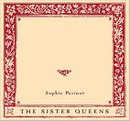 (which I distribute to book clubs I visit virtually) and I will sign and send one each to the first people to spot, snap and send photographs of The Sister Queens from Maine ,Vermont, Massachusetts and Connecticut.
(which I distribute to book clubs I visit virtually) and I will sign and send one each to the first people to spot, snap and send photographs of The Sister Queens from Maine ,Vermont, Massachusetts and Connecticut.
Just post a comment below letting me know you’ve spotted The Sister Queens (and where) or use the contact form here at the website. I’ll let you know how to get your photo to me and you can let me know where you want your bookplate mailed.
Sex and the Historical Novelist
Birds do it, bees do it, and our ancestors most definitely did it, but should sex be included in the pages of historical novels?  Today at Peeking Between the Pages I discuss the expansion of sexual content from historical romance into straight historical fiction and my views on this trend.
Today at Peeking Between the Pages I discuss the expansion of sexual content from historical romance into straight historical fiction and my views on this trend.
Meanwhile, the latest review of The Sister Queens is in! The Broke and the Bookish says:
an excellent slice of an extremely interesting period of time. We get the politics and social aspects of not one but two countries (always a bonus!) as well as in the latter part of the book, Louis’ crusade to theHoly Land. I felt very connected to them and their personalities were extremely opposite and varied. I enjoyed watching the sisters grow from young teenagers to mature mothers, queens, and friends. Recommended to all historical fiction lovers!
A Reluctant Time Traveler
Today I am guest blogging at The Book Vault. My gracious host, Dominique, asked me to consider which era I’d like to visit if I could travel back in time, and what I would do once I got there. If you think you know where I would head, my answer may surprise you.
It’s Launch Day Mes Amis!!!!
It is launch day at last! I am off to celebrate at a luncheon including two of my favorite historical authors—Kate Quinn and Stephanie Dray. But don’t hate me.
The truth is, launching a book involves more work (and sheer terror) than it does champagne. And what launching a debut novel entails in this age of social media is one of the topics I discuss today at The Paperback Swap. Other subjects on the table—why I chose to focus The Sister Queens on only two of the four daughters of Raymond Berenger, Count of Provence; a family controversy about whether I am more like Marguerite or Eleanor; and the book I am working on next. 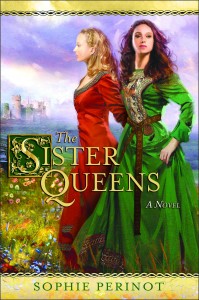
Oh and you just might win a copy of The Sister Queens in the Paperback Swap giveaway.
Confessions of a Closet “Description Minimalist
Today my blog travels take me to Just One More Paragraph where I confess (oh heresy) that too much description in a historical novel (even of very lovely gowns) causes my eyes to glaze over. How about you?
Come over, read my viewpoint on the effective uses of descriptive language in historical writing, and share yours. While you’re there enter to win a copy of The Sister Queens.
Gifts My Sister Gave Me – Part II: The Giveaway
A sister is a gift. Whether she is the mirror allowing us to see ourselves clearly when we’ve imagined we are somebody we are not, or whether she is a cautionary tale whose mistakes we act to avoid, our sisters shape us in profound ways.
Last week I shared how my sister gave me the gift of reinvention – reinvention as a writer. Today, I am interested in hearing about your sister – specifically I want to know what positive gift or gifts she has given you. I don’t mean that cashmere sweater she sent you for Christmas. I want to know the good stuff — how she made you the person you are today, opened your eyes to something you might not have seen, or otherwise shaped you for the better. The floor (or rather the comments section) is open.
And, in celebration of the fact that my novel, The Sister Queens, makes its debut one month from today I am going to make the sharing fun. I will select two individuals from among those posting their comments (about their sister–see above) to this blog by midnight February 12th and send each of them TWO (2) signed “advance-reader “copies of The Sister Queens – one for themselves and one for their sister. 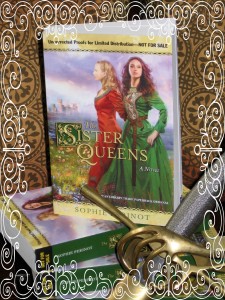 That means the winners will have galleys of The Sister Queens before anyone can purchase the novel.
That means the winners will have galleys of The Sister Queens before anyone can purchase the novel.
Check this comment thread Monday, February 13th (one week from today) for names of the winners and instructions for those lucky two. Bonne chance!
Women’s Work — Trobairitz, the First Female Composers of Western Secular Music
In the High Middle Ages the Occitan speaking world – of which Provence was a part – brought Europe a group of poet composers called troubadours. These musicians and their tradition of composing songs of courtly love, chivalric bravery, and bawdy humor quickly spread throughout much of Europe. The influence of troubadours and their work-product can hardly be overstated. Their verses were a stepping stone for virtually all of western literature that followed. Without the troubadours it is unlikely we would have Dante or Chaucer just to scratch the surface.
Who were the troubadours? Probably not who most people think.
Popular imagination tends envision troubadours as itinerant. In fact, they often attached themselves for long periods of time to a single court, enjoying the patronage of a nobleman or woman.
Nor were they vagabonds (romantic as that might seem). The earliest troubadours were members of the nobility, including the highest ranks. Ruling Dukes and Counts could be troubadours (e.g. William IX of Aquitaine a very early troubadour, and grandfather of Eleanor of Aquitaine, was a Duke). Even Kings—including Richard I of England; Thibaud I, King of Navarre (and Count of Champagne for good measure); and Alfonso X, King of Castile—were known to dabble as poet-musicians. Only gradually did individuals of the lower classes (merchants and tradesmen generally, rather than the truly poor) join their numbers. This makes sense given the fact that troubadours wrote a type of sophisticated verse that would be greatly facilitated (and may arguably have required) the writer to be a “person of letters” (educated).
Contemporary audiences also tend to think of troubadours as exclusively male. They were not. In medieval Occitania composing original poetry and setting it to music could be and was women’s work as well as men’s. The women who pursued this occupation were called trobairitz and they were the FIRST female secular poets and female composures of secular music in the western world.
Of the more than four hundred troubadours whose names are still known to scholars today, about twenty–or roughly 5%–can be positively identified as women, but women may well have been a higher percentage (is not always easy to distinguish the work of a trobairitz from that of a troubadour and it is also possible that some women used male pseudonyms for their work).
Like my Sister Queens, the female trobairitz came almost exclusively from the Occitan cultures (there are know trobairitz from Provence, Auvergne, Languedoc, Dauphine, Toulouse and Limousin). This is likely not a coincidence.
Circumstances in early 13th century Occitania created the perfect storm for the emergence of these secular women poets. Women of this region administered great estates—dispensing justice and defending property—at a time when such roles were far less common elsewhere in Europe. Why? First, they were able to inherit and govern territory in their own right. But perhaps more importantly, a nearly continuous string of crusades resulted in a large loss of Occitan men either temporarily or permanently (when a nobleman died or simply decided to stay in the Crusader States). And while their fathers, husbands and brothers were absent women throughout Occitania were left in charge of administering family holdings.
What the trobairitz wrote is as startling as the sudden emergence of these woman poets. Trobairitz used their voices to emphasize their desires and to assert their right to have love and passion in their lives. Consider this excerpt from a work of the most well known trobairitz, the Countess of Dia:
I should like to hold my knight
Naked in my arms at eve,
That he might be in ecstasy
As I cushioned his head against my breast . . .
I grant him my heart, my love,
My mind, my eyes, my life.
These are the words of noble women with enough self-assurance to express and defend not only their actions in taking lovers but their emotions and their passions. They also often emphasized feminine values both setting forth ideal love and in defining the valorous male. Pretty remarkable for the 13th century.
The period of the trobairitz was fleeting. They first appear in the literature early in the century and most of their writings are dated up to and through the 1260s. By 1280 they had disappeared entirely. While this may seem sad, it can be taken as a more positive reminder that history is not linear—even those periods when the roles of women were heavily circumscribed have been punctuated by moments of female progress and power.
If you are interested in hearing the words of the trobairitz as they were meant to be—sung—there are a number of excellent recordings (e.g. In Time of Daffodils: Songs of the Trobairitz, The Sweet Look And The Loving Manner – Trobairitz, Love Lyrics and Chansons de Femme from Medieval France or The Romance Of The Rose – Feminine Voices From Medieval France)
I will leave you with one of my favorites–a rendition of a poem by the Countess of Dia
A Glimpse of 13th Century London Through Matthew Paris’s Eyes
Another image to share. This one still and far older than the video I posted yesterday.
Here for your enjoyment is A drawing of London by the chronicler Matthew Paris from his Historia Anglorum, Chronica majora, Part III; Continuation of Chronica maiora. This manuscript is now in the collection of the British Library.
This sketch is believed to have been executed between 1250 and 1259.
